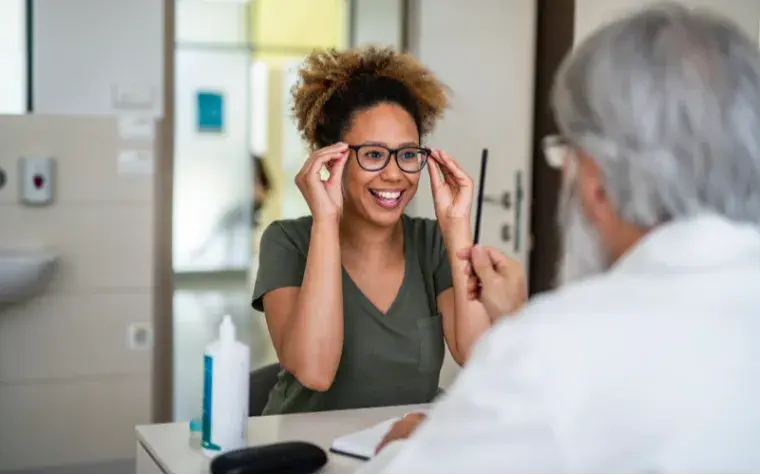Buy one pair of eyeglasses, get a second pair 50% off!
*Restrictions apply. Click here for details.

What does it mean to have 20/20 vision?
Roughly a third of the population in the United States enjoys the clarity of 20/20 vision. This common expression originates from the standard measurement system used by eye care professionals to gauge how your sight measures up to what is typically expected. This is tested by positioning you at a distance of 20 feet from a vision chart and asking you to identify the smallest set of letters you can see.
Achieving 20/20 vision means that when you're positioned at the 20-foot mark from the chart, you can distinguish the letters that someone with standard vision can also see at that range. Essentially, "20/20" is an indication that your vision is clear and sharp at 20 feet – just like that of an average person with good eyesight.
What if you don’t have 20/20 vision?
If your vision isn't quite as clear as the standard 20/20, you might discover that you have 20/40 or even 20/100 vision. This essentially means that what you can see clearly at 20 feet can only be seen by a person with standard vision from 40 or 100 feet away. Variations like these often point to refractive errors, which means your ability to see distant objects might not be as crisp as those with 20/20 vision. To accurately determine your vision clarity, an eye care specialist would use a Snellen chart during your eye examination. This chart helps in assessing how sharp your eyesight is at varying lengths. It's not unusual to have different vision clarity in each eye, which can sometimes affect how well you perceive depth and coordinate your movements.
For personalized care and more details, make an appointment with Grene Vision Group.
20/20 vision is NOT perfect vision.
Achieving 20/20 vision may not be the same as perfect vision, but it does signify that your eyesight is as good as the average person – that is, you can see clearly without corrective lenses.
Interestingly, there are individuals whose eyesight is better than 20/20. For instance, those with 20/15 vision are able to discern details at 20 feet that a person with typical vision might need to be at 15 feet to see just as clearly. An even rarer group can boast of 20/10 vision, perceiving at a 20-foot distance what most would need to step closer to 10 feet to see with the same clarity.
You may need glasses if you have 20/20 vision.
Some people with 20/20 vision (or even 20/10 vision) may still need to wear glasses or contact lenses. That's because a 20/20 measurement needs to take into account things like whether you can discern colors properly or how well your peripheral vision and depth perception work. A simple eye chart test can't measure depth perception or if the shape of your eye affects your ability to see clearly.
Your eye health is more than a number.
Even if you have 20/20 or 20/10 vision, you might still need glasses or contacts. This is because having 20/20 vision doesn't tell you everything about your eyes, like how well you see colors or what’s happening in your side vision. It also doesn’t say if you have depth perception issues or if the shape of your eye changes how you see. Eye tests with charts are good, but they don't catch everything about your eye health. Age can also impact your vision. After the age of 40, many people can't focus well on close-up items that they used to be able to see clearly. They may need to wear reading glasses due to age-related vision changes despite otherwise having 20/20 vision.
Finally, there are people with 20/20 vision who have astigmatism and blurry vision as a result of an irregular eye shape. These people may also need to wear glasses or contact lenses to improve blurry vision.
Remember, your vision is so much more than a couple of numbers!
You can use corrective lenses to achieve 20/20 vision.
If your vision isn't quite 20/20, glasses or contacts can help you see better. Most people who wear them can pass a vision test with 20/20 vision. But not everyone will get to 20/20 with glasses or contacts, and that's okay. It's still good to know how clear your vision is. When you drive, for example, you need to see at least 20/40 with your glasses or contacts to get your driver's license. If your best with glasses is 20/200, you are considered legally blind.
Remember, 20/20 vision isn't perfect vision. It just means you can see well from far away. Going to the eye doctor is the best way to find out how good your vision is and if glasses or contacts can make it clearer.
For all your eye care needs, schedule a visit at your local Grene Vision Group.

 316-636-2010
316-636-2010 316-609-2177
316-609-2177